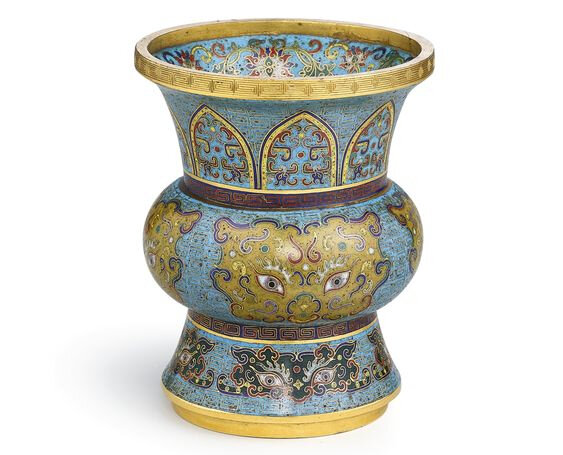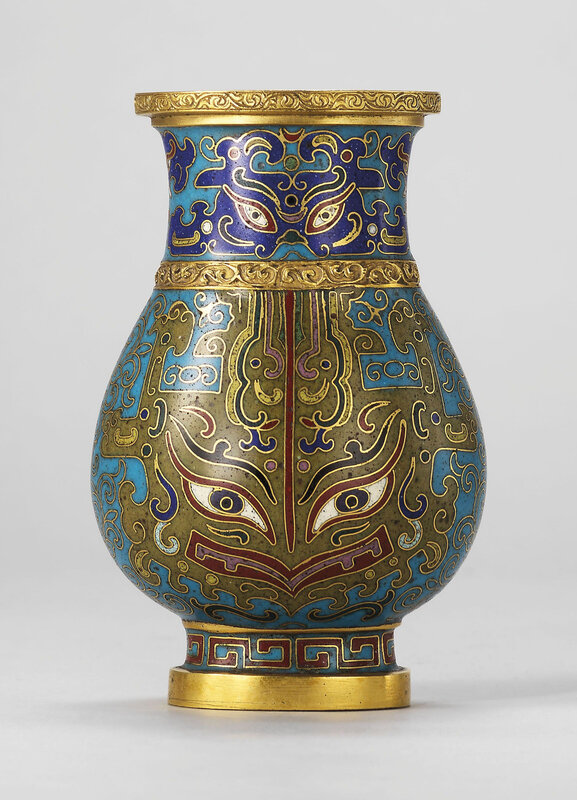A rare cloisonné enamel and gilt-bronze archaistic 'taotie' vessel, zun, Mark and period of Qianlong (1736-1795)
Lot 3517. A rare cloisonné enamel and gilt-bronze archaistic 'taotie' vessel, zun, Mark and period of Qianlong (1736-1795); 15.1 cm, 5 7/8 in. Estimate 1,800,000 — 2,500,000 HKD. Lot sold 4,495,000 HKD (579,001 USD). Courtesy Sotheby's.
cast with a compressed globular central section resting on a splayed foot and flaring at the trumpet mouth, the bulbous mid-section superbly enamelled with four golden-olive taotie masks highlighted with multi-coloured outlines formed of scrollwork, between two key-fret bands encircling the lower and upper sections of the neck and foot respectively, the foot similarly decorated with four green taotie masks, all below a frieze of upright plantain blades enclosing kui phoenix bordering the neck, all against a bright turquoise ground with fine keyfret wires and below a gilt-bronze rim decorated with a keyfret band, the inner neck further decorated with a turquoise-ground border enclosing a luxuriant lotus scroll issuing blooms of varying sizes interspersed with leaves and tendrils, the base centred with a four-character reign mark within a double square.
Provenance: Collection of Alfred Morrison (1821-1897), Fonthill House, Tisbury, Wiltshire.
Christie's London, 9th November 2004, lot 45.
Note: Superbly decorated in bright cloisonné enamels with taotie masks, the present vessel with its flaring neck atop the bulbous central section and splayed foot, is a remarkable testament to the skilled craftsmanship of the Qianlong reign and the Emperor’s fascination with archaism. The present vessel belongs to a special group of vessels that took their inspiration from archaic ritual bronzes, which can be seen from not only its form but also its stylistic decoration that echoes that of archaic vessels.
The choice of decoration against the bright turquoise ground shows a notable emulation of early bronze ritual vessels, which is evident in the main and subsidiary taotie masks, the plantain blades and the kui phoenix encircling the trumpet neck, as well as the thin wires of leiwen motifs in the bright turquoise ground.
According to a record from the Zaobanchu Archives of the Qing Imperial Household Department, on the 25th day of the 11th month in the 39th year of the Qianlong reign, it was decreed that a cloisonné enamel ware was to be made for the Dongnuange (‘East Warm Pavilion’) in the Ningshougong (‘Palace of Tranquil Longevity'). A draft of a cloisonné enamel zun was presented on the same day to the eunuch for the Emperor’s inspection. The imperial decree was received that the draft was to be decorated for further inspection and a jade moonflask was to be replaced upon the production of the cloisonné enamel ware. On the 27th day of the month, upon submission of a decorated draft, the imperial decree was received that the zun was to be made following the draft with the plantain and kui-phoenix designs. On the 18th day of the 1st month of the 4[0]th year, a cloisonné enamel zun and zitan stand were presented to the eunuch for the Emperor’s inspection and it was decreed that the gilt areas of the zun were to be re-gilt with the interior gilt.
Cloisonné enamel production was rigorously monitored during the Qianlong reign. It is notable that in the 33rd year of his reign, it was ordered that the gilding of cloisonné enamel wares was to be executed at least three times to further encapsulate the imperial splendour.
Only a small number of these vessels appears to be recorded. For a closely related Qianlong reign-marked example of the same size, similarly decorated with taotie masks, see The Complete Collection of Treasures of the Palace Museum. Metal-bodied Enamel Ware, Hong Kong, 2002, no. 115. See another similar Qianlong marked vessel of a slightly larger proportion, in the Uldry collection, illustrated in Helmut Brinker and Albert Lutz, Chinese Cloisonné: The Pierre Uldry Collection, London, 1989 (German edition Zurich, 1985), no. 268.
The incorporation of golden-olive taotie masks complemented with two blue subsidiary taotie masks is also seen on a cloisonné enamel hu-shaped vase with the same four-character reign mark cast in relief, sold at Christie’s London, 15th May 2018, lot 3.
A small cloisonné enamel pear-shaped vase, Hu, Qianlong four-character mark cast in relief within a square and of the period (1736-1795); 4 3/8 in. (11.2 cm.) high. Sold for 97,500 GBP at Christie's London, 15th May 2018, lot 3. © Christie's Images Ltd 2018
Sotheby's. Scholarly and Imperial Works of Art from a Distinguished Collection, Hong Kong, 03 Apr 2019

/https%3A%2F%2Fprofilepics.canalblog.com%2Fprofilepics%2F1%2F0%2F100183.jpg)
/https%3A%2F%2Fstorage.canalblog.com%2F03%2F02%2F119589%2F96711876_o.jpg)
/https%3A%2F%2Fstorage.canalblog.com%2F11%2F31%2F119589%2F94773502_o.jpg)
/https%3A%2F%2Fstorage.canalblog.com%2F20%2F83%2F119589%2F94772815_o.jpg)
/https%3A%2F%2Fstorage.canalblog.com%2F26%2F72%2F119589%2F75604929_o.jpg)
/https%3A%2F%2Fstorage.canalblog.com%2F59%2F60%2F119589%2F26458628_o.jpg)







/http%3A%2F%2Fstorage.canalblog.com%2F04%2F42%2F119589%2F129831017_o.jpg)
/http%3A%2F%2Fstorage.canalblog.com%2F53%2F21%2F119589%2F129409104_o.jpg)
/http%3A%2F%2Fstorage.canalblog.com%2F79%2F64%2F119589%2F129153779_o.jpg)
/http%3A%2F%2Fstorage.canalblog.com%2F97%2F23%2F119589%2F128165935_o.jpg)